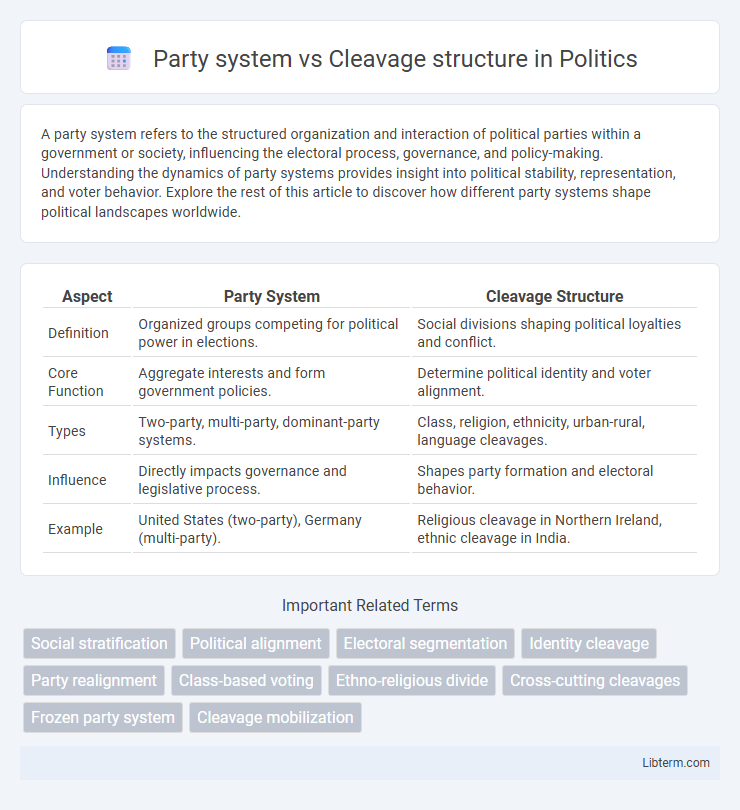A party system refers to the structured organization and interaction of political parties within a government or society, influencing the electoral process, governance, and policy-making. Understanding the dynamics of party systems provides insight into political stability, representation, and voter behavior. Explore the rest of this article to discover how different party systems shape political landscapes worldwide.
Table of Comparison
| Aspect | Party System | Cleavage Structure |
|---|---|---|
| Definition | Organized groups competing for political power in elections. | Social divisions shaping political loyalties and conflict. |
| Core Function | Aggregate interests and form government policies. | Determine political identity and voter alignment. |
| Types | Two-party, multi-party, dominant-party systems. | Class, religion, ethnicity, urban-rural, language cleavages. |
| Influence | Directly impacts governance and legislative process. | Shapes party formation and electoral behavior. |
| Example | United States (two-party), Germany (multi-party). | Religious cleavage in Northern Ireland, ethnic cleavage in India. |
Introduction to Party Systems and Cleavage Structures
Party systems refer to the organization and interaction of political parties within a political framework, shaping electoral competition and governance dynamics. Cleavage structures describe deep, enduring societal divisions based on social, economic, religious, or ethnic identities that influence political alignments and party loyalty. Understanding the relationship between party systems and cleavage structures reveals how social divisions translate into political representation and affect party competition patterns.
Defining Party Systems: Types and Characteristics
Party systems categorize the organization and interaction of political parties within a state, typically classified into single-party, two-party, or multi-party systems based on the number of relevant parties. Each party system type influences political competition, governance stability, and voter alignment differently, with multi-party systems facilitating coalition governments and two-party systems promoting majoritarian rule. The cleavage structure, referring to deep social divisions such as class, religion, or ethnicity, shapes party systems by aligning political parties along these societal fault lines, thereby affecting party formation and electoral strategies.
Understanding Cleavage Structures in Society
Cleavage structures in society refer to deep, enduring divisions based on factors like class, religion, ethnicity, or ideology that shape political alignments and social group identities. These cleavages often influence the party system by determining the formation, loyalty, and competition of political parties representing distinct societal interests. Understanding cleavage structures reveals how societal conflicts become institutionalized within political parties, guiding electoral behavior and policy preferences.
Historical Development of Cleavages and Party Systems
The historical development of cleavages shapes party systems by defining social divisions that political parties represent, such as class, religion, or ethnicity. These entrenched societal cleavages lead to the formation of stable party systems that reflect underlying social conflicts, influencing electoral alignments and policy orientations. Over time, shifts in economic conditions, social values, and political reforms can alter cleavage structures, resulting in realignments or transformations within party systems.
Theoretical Approaches: Lipset and Rokkan’s Cleavage Model
Lipset and Rokkan's Cleavage Model theorizes that party systems emerge from deep-seated social cleavages, such as class, religion, and ethnicity, that structure political competition over time. Their framework explains how historical events like the Industrial Revolution and nation-state formation created enduring societal divisions that shape voter alignment and party formation. This model remains pivotal in analyzing how cleavage structures inform the persistence and evolution of party systems across democracies.
Relationship Between Cleavage Structures and Party Systems
Cleavage structures such as class, religion, ethnicity, and urban-rural divisions shape party systems by influencing political alignments and voter loyalties. These social divisions create stable groups whose interests are represented by specific political parties, resulting in either a multiparty or two-party system depending on the number and salience of cleavages. The strength and persistence of cleavages directly affect party system fragmentation, polarization, and coalition dynamics.
Impact of Social Cleavages on Political Alignment
Social cleavages such as class, religion, ethnicity, and language significantly shape party systems by influencing political alignments and voter behavior. Parties often emerge or realign to represent key social divisions, embedding these cleavages into the political structure and reinforcing group identities. The impact of social cleavages manifests in the stability or volatility of party systems, determining whether societies experience bipartisan competition or fragmented multiparty arrangements.
Evolution of Party Systems in Response to Cleavage Changes
Party systems evolve as social cleavages shift due to changes in economic development, cultural values, and identity politics, leading to the realignment or fragmentation of political parties. The decline of traditional class-based cleavages often results in the emergence of new issues such as environmentalism, immigration, and regional autonomy, which reshape party platforms and voter alignments. This dynamic interplay between cleavage structures and party systems drives electoral volatility and the formation of new coalition patterns in contemporary democracies.
Comparative Analysis: Case Studies Across Democracies
Party systems shape electoral competition and political representation by organizing interests into coherent groups, while cleavage structures underpin societal divisions such as class, religion, and ethnicity that influence party alignments. Comparative analysis across democracies like Germany, India, and the United States reveals that complex cleavage structures often lead to multiparty systems, whereas societies with fewer salient cleavages tend to exhibit two-party dominance. Case studies demonstrate how historical context and social fragmentation determine the interaction between cleavage formations and party system institutionalization, affecting political stability and policy outcomes.
Contemporary Challenges and Future Trends
Contemporary challenges in party systems involve managing increasing political fragmentation and voter realignment driven by evolving social cleavages such as ethnicity, religion, and economic inequality. Future trends suggest a shift toward more fluid party affiliations and issue-based coalitions that transcend traditional cleavage structures, demanding adaptive strategies for maintaining political stability. Digital communication and globalization further complicate the cleavage-party system relationship by reshaping voter identities and mobilization patterns.
Party system Infographic

 libterm.com
libterm.com